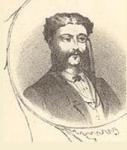Dramatist, composer, journalist.
Described in one source as a 'thorough Bohemian in his habits and a most genial companion' (Brisbane Courier 4 September 1915, p.12), William Mower Akhurst is regarded as the first Australian-resident dramatist to have a significant impact on the local popular theatre industry. He arrived in Adelaide in 1849 aboard the barque Posthumous, having spent several years on the London stage (a number of his works were staged at London's Cremorne Gardens). In Adelaide Akhurst became secretary of a local amateur dramatic society. He relocated to Melbourne ca. 1853 and within ten years he established himself as one of the most prolific and significant dramatists in Australian popular theatre history. Specialising in writing, directing, and sometimes composing musical comedies, pantomimes, burlesques operettas, and farces, he collaborated with George Coppin and composer Sydney Nelson, among others. Akhurst's first Australian works, which included several collaborative efforts with Nelson, were written primarily for the Nelson and Buckingham family troupes (ca. 1853).
Akhurst's first pantomime was Harlequin LSD (1855), and this was followed on a regular basis throughout the next decade and a half. All his works had strong topical interest, containing frequent allusions to Melbourne and Victorian personalities, issues, localities, and circumstances. In 1862, he devised the Harlequin Arabian Nights pantomime for W. S. Lyster's Royal English and Italian Opera Company, and around this time also provided operatic burlesques for the American blackface troupe Christy's Minstrels. An 1868 adaptation of Jacques Offenbach's operetta Un Mari à la Porte (libretto by A. Delacour and L. Morand) was retitled by Akhurst as The Wrong Side of the Door.
The majority of his musical numbers were adapted from light operas or popular songs, into which he inserted new words in accordance with the dramatic action. Akhurst did, however, compose songs for specific performers or scenes. The music he wrote for a ballad and a polka were, for instance, published in the July-August 1863 edition of the Illustrated Melbourne Post, while a waltz was included in an 1864 edition of the same magazine. The libretti for some of his pantomimes were also published in Melbourne during the 1860s.
Two of Akhurst's longest running works were the burlesques Ixion (1866), which had a run of 47 performances, and the 1868 production Paris the Prince and Helen the Fair (aka The Siege of Troy), which exceeded the Ixion season by several performances. Several of Akhurst's works were also adapted by other local writers and producers, including three versions of The House that Jack Built. The first adaptation, staged in 1871, was Jack Sydney, while a Brisbane version, adapted as Jack Brisbane, was produced in 1878. His Harlequin Jack Sheppard was re-worked as Sambodom and Pompedom's Dream in 1869 by Weston and Hussey. One of his final successes in Australia was The Battle of Hastings (1869), which some theatre historians have suggested helped firmly establish the popularity of extravaganzas in Melbourne.
In 1869, Akhurst returned to Britain, where he wrote at least nine pantomimes, four dramas, two extravaganzas, one burlesque, and several equestrian spectacles for Lord George Sanger (Astley's Theatre). One of these, an extravaganza entitled To the Green Isles Direct, which he adapted from Lecoq's 1872 opera Les Cents Vierges (The One Hundred Virgins) was staged in London in 1874 before being accepted for production in Australia by W. S. Lyster and Henry Bracy the following year. In Australia, it was billed as Les Cent Vierges; Or, The One Hundred Virgins. In 1878, having not achieved the same level of success in London as he had in Melbourne, he once again sailed for the Antipodes. However, on 6 June 1878, while three weeks out to sea aboard the SS Patriarch, he collapsed and died of apparent brain paralysis.
The Brisbane Courier records that Akhurst's creative gift was his ability to rhyme and 'his faculty for making word-torturing puns - with which burlesques were crammed at the period he wrote' (4 September 1915, p.12). His great career achievement, however, was becoming the only local writer of the era to match and even surpass the success of foreign dramatic imports. Despite being relegated almost to a footnote in Australian theatre history, his legacy of work still ranks among the most successful the country has produced.
